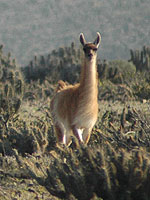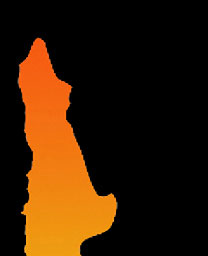

|
Wild Wild Life: Day One in Punta de ChorosI headed north on the Ruta 5, driving through a desert landscape interspersed with lush green valleys. It was around this point that I passed the 500-kilometer marker from Santiago. Then I got to Coquimbo and La Serena. These two cities are right next to each other, the former a big port and the latter an old colonial city, the second oldest in Chile after Santiago. What a mess it was to be back in an urban environment. Traffic congestion, massive construction projects all along the highway, and lots of unexpected obstacles. I had some errands to run, so I stopped a couple of times in La Serena. I bought some groceries, including some more pan amasado, as well as some good cheap wine. I then went to the Plaza de Armas in the historic heart of the city and found a bank where I could use the ATM. I need more cash now as I head into wilder territories and places where credit cards will not be widely accepted. North of La Serena, the highway gets really bad. The beautiful open highway had turned into an industrial nightmare filled with gigantic trucks and endless construction. I finally reached the turnoff for Punta de Choros, although I still wasn't sure I had the right road, in spite of the sign. I spotted two men standing by a small building next to the road and stopped to ask them if this was the road to Punta de Choros, just to reassure myself. This was how I met Carlos and Lionel. I gave Carlos and Lionel a ride most of the way down to Punta de Choros. Carlos was an older man, who together with his son Lionel was making the trip from Trapiche back to their paracel in the desert. A paracel is a small parcel of land that families have settled on for generations, eeking out an existence in this harsh environment. They drill deep artesian wells and plant olivares, or groves of olive trees. I was happy to help them out with a lift, and it also assured that I wasn't going to get lost on the way down to Punta de Choros. The one-hour ride was a great lesson for me in Chilean Spanish. Carlos spoke very fast, using a lot of Chilenismos, and running his words together in a way that made him very difficult to understand. Lionel seemed to pick up on my confusion and took care to "translate" what his father said into more standard Spanish. About half-way down to Punta de Choros, Lionel spotted a herd of guanacos grazing out in the desert, about 100 yards from the road. This is the time of day when the guanacos are out feeding, so it is a great time to see them. Unlike the camel or the llama, the guanaco (Lama guanicoe) is wild and was never domesticated. We got out of the car and watched them as they grazed, in all their graceful beauty. Later when we continued down the road, part of the herd crossed right in front of us, so we were able to get a close-up look. Even though Carlos and Lionel see these animals on a regular basis, it was apparent that they felt a sense of awe as much as I did. I dropped Carlos and Lionel off at their paracel, a small patch of land just past the pueblo of Choros. I got out of the car to help them unload their belongings from the trunk. We said our goodbyes and Carlos gave me a big hug. I realized how much you can get to know a Chilean in just one hour. I arrived in Punta de Choros just before sunset and found a small cabaña on the beach. It was a great place to watch the sunset behind Isla Choros, one of the offshore islands. I had a simple dinner of pan amasado, queso de cabra, and a good Chilean white wine. Who could ask for more? |
||||||||||
|
|||||||||||
 |
|||||||||||
|
© 2015 Michael Hanrahan
|
|||||||||||


